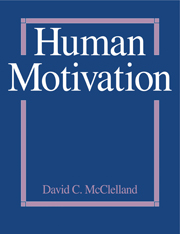Book contents
10 - The Avoidance Motives
Published online by Cambridge University Press: 05 July 2014
Summary
For historical reasons, as explained in Chapter 3, academic psychologists first conceived of motives as efforts to avoid discomfort and to reduce strong Stimulation, whether caused by hunger, thirst, pain, electric shock, conflict, or frustration. They found it easy to observe the effects of such strong Stimulation on their favorite subjects—namely, animals in the laboratory—and they believed that psychoanalysts working with patients had confirmed their view that anxiety reduction was a kind of master motive. From this point of view it did not make much sense to think in terms of different kinds of avoidance motives: Individuals simply learned different ways of reducing their anxiety, and these might be as varied as the number of people studied. Thus, one person might reduce his or her anxiety by chewing gum, another by jogging, and a third by going to the movies.
It did not make sense to try to define and measure a gum-chewing motive, a jogging motive, or a movie-going motive, so not much attention has been given to sophisticated measurement in this area such as has characterized the work on measuring n Achievement or n Power. In the beginning, scholars were satisfied with simple reports by individuals as to how anxious they felt.
- Type
- Chapter
- Information
- Human Motivation , pp. 373 - 412Publisher: Cambridge University PressPrint publication year: 1988



